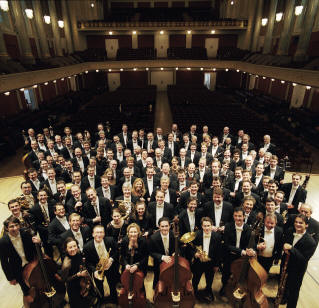- Vienna Symphony
Infobox musical artist
Name = Vienna Symphony

Background = classical_ensemble
Alias = VSO
Origin = flagicon|AUTVienna ,Austria
Genre = Classical
Occupation =Symphony orchestra
Years_active = 1900-"present"
Associated_acts =
URL = [http://www.wiener-symphoniker.at www.wiener-symphoniker.at]
Current_members = Principal ConductorFabio Luisi
First Guest ConductorYakov Kreizberg
Past_members = FounderFerdinand Löwe
Notable_instruments = The Vienna Symphony ( _de. Wiener Symphoniker) is anorchestra inVienna ,Austria .History
The orchestra was founded in 1900 by
Ferdinand Löwe as the "Wiener Concertverein" (Vienna Concert Society). In 1913 it moved into theKonzerthaus, Vienna . In 1919 it merged with theTonkünstler Orchestra . In 1933 it acquired its current name. Despite a lull in concert attendance after the introduction of theradio during the 1920s, the orchestra survived until the invasion of Austria in 1938 and became incorporated into theGerman Culture Orchestra s. As such, they were used for purposes ofpropaganda until, depleted by assignments to work in munitions factories, the orchestra closed down onSeptember 1 1944 .Their first post-war concert occurred on
September 16 1945 , performingGustav Mahler 's "Symphony No. 3". Under the direction ofJosef Krips , they quickly rebuilt a modern repertoire after ten years of isolation and travelled to theBregenz Festival for the first time in the summer of 1946.1946 marked the beginning of the tenure of
maestro Herbert von Karajan who, though not principal conductor, worked with the VSO in the "Karajan Series" concerts, going on extensive tours throughout Europe and North America. In 1959 the VSO performed forPope John XXIII atVatican City leading up to the debut of maestroWolfgang Sawallisch .Sawallisch's leadership saw a tour of the
United States in 1964 as well as a combined U.S.-Japan tour in 1967. It also included the re-opening of theTheater an der Wien in 1962.Krips returned in the interim between Sawallisch's departure and the arrival of
Carlo Maria Giulini as principal conductor. In the 1980sGeorges Prêtre took over the maestro's podium and increased the number of concerts on the VSO's schedule as well as infused their repertoire with French music.The early 1990s saw
Rafael Frühbeck de Burgos take over as principal conductor, introducing Spanish music much as Prêtre did.Vladimir Fedosejev became principal conductor in 1997.Principal conductors
*1900-1925
Ferdinand Löwe
*1920s-1930sWilhelm Furtwängler "(as director of theGesellschaft der Musikfreunde )"
*1933-1940sOswald Kabasta
*1946-1948Hans Swarowsky
*1948-1960Herbert von Karajan "(as director of theGesellschaft der Musikfreunde )"
*1960-1970Wolfgang Sawallisch
*1970-1973Josef Krips (artistic advisor)
*1973-1976Carlo Maria Giulini
*1980-1982Gennady Rozhdestvensky
*1986-1991Georges Prêtre (first guest conductor)
*1991-1996Rafael Frühbeck de Burgos
*1997-2005Vladimir Fedoseyev
*2005-"present"Fabio Luisi ee also
*
Vienna Philharmonic
*Vienna Chamber Orchestra References
*
*External links
*allmusic|41:8229
Wikimedia Foundation. 2010.
